Archive for the ‘Paper & Desk’ Category
This morning I’m trying something new.
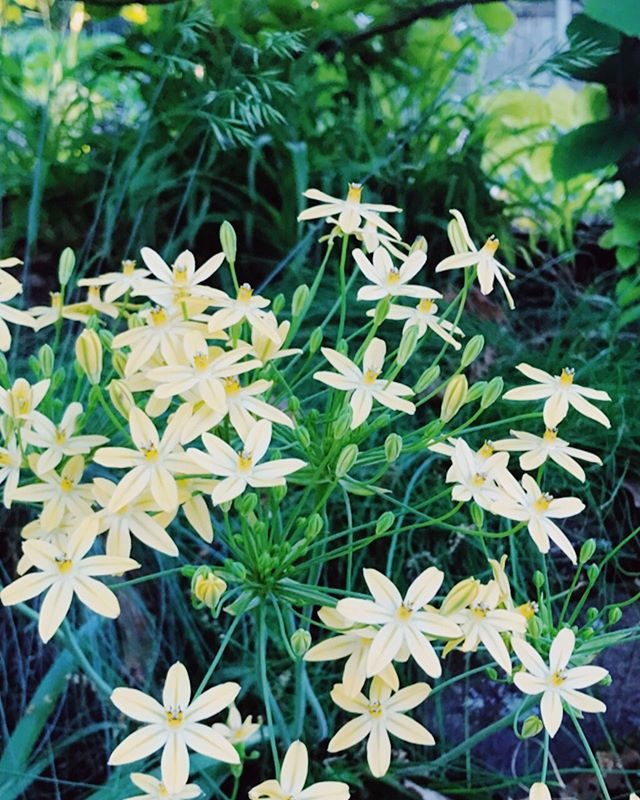
I noticed that this week’s morning poetry-reading-and-writing-time kept getting interrupted (the writing part, at least) by scritchy angsting over my daily schedule—how to fit it all in, “it” being homeschooling and house-tending and paying work and personal projects and long walks and gardening and reading and TV and doctor appointments and fun time and down time and sleep—oh, the days are so wonderfully, terribly full. When it hit me that I kept returning to logistical questions during the precious minutes I give myself for freewriting, I realized my brain was trying to tell me something. So I leaned into the questions instead of impatiently shooing them away.
I know I try to fit too much in. But there are ways it works, if I’m thoughtful and honest with myself. (For example: no matter how many times I tell myself I’m going to read in bed, I know I’ll just fall asleep within a paragraph or two and I need to give myself some other space during the day for real reading.)
This morning’s insight was that no matter how often I write an after-dinner blogging interval into my schedule, I won’t use it for blogging. Especially now, when the long evening light is amazing and my feet carry me out the door almost before my mind realizes what’s happening.
Or yesterday, when I said: I’ll blog between lunch and work. Naturally, this meant I went out to the garden to prune and weed and rhapsodize over this week’s wave of bloom. (Poppies, pincushion flower, snapdragons, begonia; and the yarrow is about to explode with color.)
So today I’m trying in the morning. Mornings might work—the loose half-hour between my poetry time and high tide. I suppose it’s another step in my shift toward digital minimalism. After I took Facebook and Twitter off my phone in early April, I gave them small containers at breakfast. I’m going to try a week of stealing those containers for Bonny Glen. I’m documenting the plan so I’ll (obliger that I am) be more likely to give it a fair shot.
I need this blog! Its archives are our family chronicle and a source of great joy. (Scott’s too. His “fambly” posts capture so many moments I wouldn’t have remembered, or wasn’t present for in the first place. And so hilariously.) And—as any Charlotte Mason educator worth her salt knows—retelling an event helps fix it in your memory. Earlier this week, a doctor was asking me about developmental milestones one of the kids. After six babies and so many years, there’s no chance I’d remember those specifics organically. But I remembered a blog post—and where I was sitting when I wrote it—and that gave me an approximate window of time.
(There’s something there worth exploring: the way the physical act of writing—where I’m sitting, what’s out the window, whether there even IS a window—becomes as much a part of memory as the words themselves.)
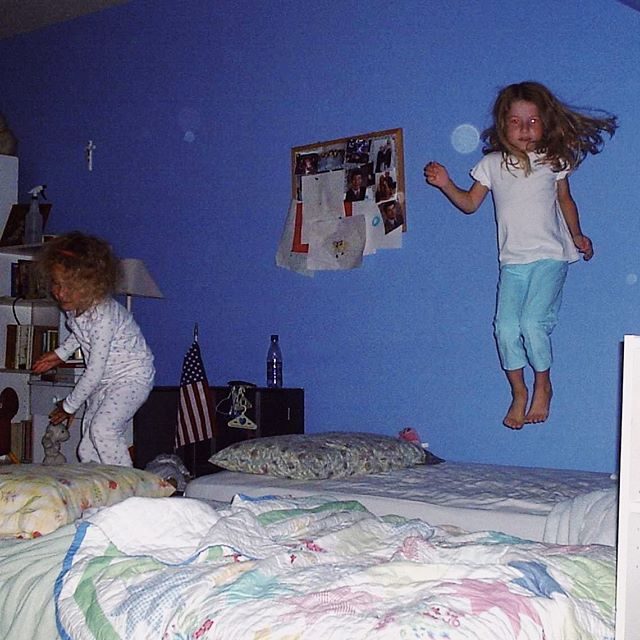
This is my thinking-aloud space, and heaven knows I’m thinking aloud right now. But I think they are thoughts relevant to others, because we’re all trying to squeeze too much magic into too little time. I know I can’t fit in everything. I also know I won’t fit in a lot of things unless I think through where to fit them. These past two years, with such a comically full plate (even for me, greedy plate-filler that I am), I had to make a concerted effort to save space for sleep, walks, and down time.
And I make a mental distinction between my kinds of work—I think of it as paying work and creative work, but those labels are clumsy because all my ‘paying work’ is creative, and of course I hope all my ‘creative work’ will earn its keep eventually. The distinction is more like: short-term, pays soon and long-term, pays someday or maybe never. Dividing it that way helped a lot! Without blocks in my schedule for the long-term personal projects, I would never get around to them. Calling those blocks “creative work” in my planner helps set the tone and mood I want when I sit down to that work—it sounds exciting and rich, not like a slog. And the “paying work” label is a good motivator too, because it says: these hours pay next month’s bills. Tangible, concrete.
Speaking of my planner, another big shift I made in April was—gulp—abandoning my beloved bullet journal for Evernote. This happened for a quite practical reason: I had gotten sloppy about maintaining the index that makes it possible to pull notes out of a bullet journal at a later date. After so many years, I have a giant bin of filled notebooks. If I need notes on a particular event or phone call (the insurance company, a doctor, an editor), I have to hunt through all those books. Even with the properly indexed ones, this is a pain!
And (again out of a fierce urge to save my time for good things) I realized that if I do the same kind of task-logging and note-taking in Evernote that I’ve been doing in my notebook, I can quickly, easily search for a note.
After a few weeks, I developed a template so I didn’t have to recreate the wheel every morning. I read this article about “interstitial journaling”—the practice of taking a few moments to write narratively about the task you’ve just completed and what you’re about to embark on next, including feelings or trepidations about it—and boom: this made so much sense to me, and after two months I can say it’s a practice that works really, really well for keeping me focused.
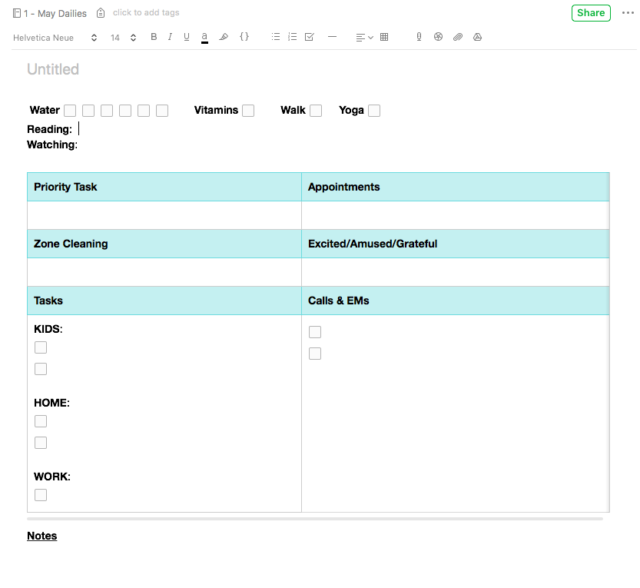
I title each note with the day and date: “Wednesday, May 22.” The “Notes” section is where my time-stamped interstitial journaling entries go. By the end of the day, there’s a full page of notes. This section has become the most important part! Turns my focus up to eleven.
I still use a paper notebook for my morning poetry pages. And lots of other things throughout the day—I’m an inveterate doodler. If I take notes on paper, now I simply snap a photo of them and save it in Evernote with a couple of tags to help me find it later.
I’m working on a longer post for Medium about this transition to Evernote. It’s funny that it grew out of digital decluttering! But interstitial journaling has been a brilliant tool for me so far, and Evernote (which I’ve used forever for various kinds of digital notekeeping) is a handy place to do it.
Right now, though, I’ve reached the end of this morning’s experimental blogging container. See you tomorrow, friends!
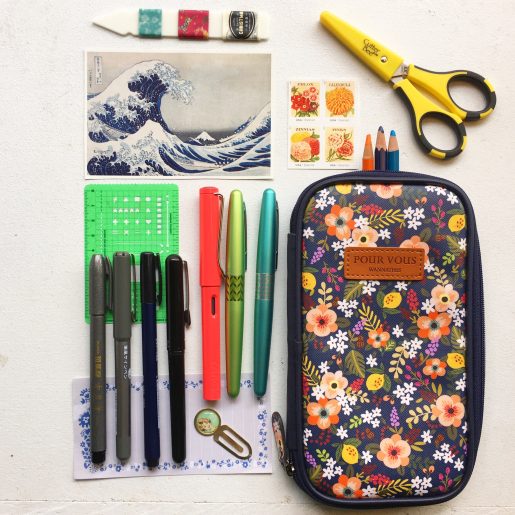
I put this on Instagram and decided to carry it over here in case anyone needs stocking stuffer ideas. 😉 The Amazon links are affiliate but not the JetPens links and the rest.
Everyday pen carry, deconstructed. Washi samples, a beloved Hokusai print I cut out of an old desk calendar, postage stamps, scissors. Hobonichi stencil, Galison notepad (last sheet, wah!), and a Reset Girl “planner honey” clip. I think the washi samples were a freebie included with an order from Etsy seller Cute Things From Japan.
Favorite drawing pens, left to right: Zebra brush pen, Kuretake brush pen in gray ink (my new love), Tombow blue body brush pen, hard tip (which I find myself reaching for more and more often—I like it better than the UniPin or Micron), Pentel Pocket Brush Pen (this one has been a total game-changer for me).
Favorite writing pens: Lamy Safari (pink), medium nib, blue-black ink. Pilot Metropolitan fountain pens, both medium nibs, one gray ink (I forget which, from a Goulet gray sampler), one my dream ink, Pilot Iroshizuku Shin-Kai, a deep navy blue.
I always carry a few Prismacolor pencils with me. Turquoise is essential to my well-being and then I always pack an orange, green, or ruby red/fuschia shade for contrast. I use these for sketching and fancy headers as well as for calling out key events in my planner, or coloring in my to-do boxes. And then I like to pack one or two Faber Castell watercolor pencils for easy planner/journal decoration. Deep blue is my favorite. (That link goes to a set of 36, with a price tag way beyond my art supply budget. I have exactly three colors of these pencils—blue, cranberry, and grape. They layer wonderfully.)
All of these inks and pigments are dreamy in my Hobonichi Cousin and Weeks planners, my Midori Travelers Notebook (I favor their 002 grid inserts), and on the flecked, recycled papers of the impossibly lovely Wild Simplicity Daybook inserts.
Floral pen case from MochiThings (I recommend watching for their sales because otherwise they’re pricey). I carry my tiny watercolor palette and waterbrushes in a separate pouch, but they fit in this case too if I leave a few pens home.
For the papery side of things—see these posts:
Planner Love
Notebooks and Sketchbooks and Planners, Oh My

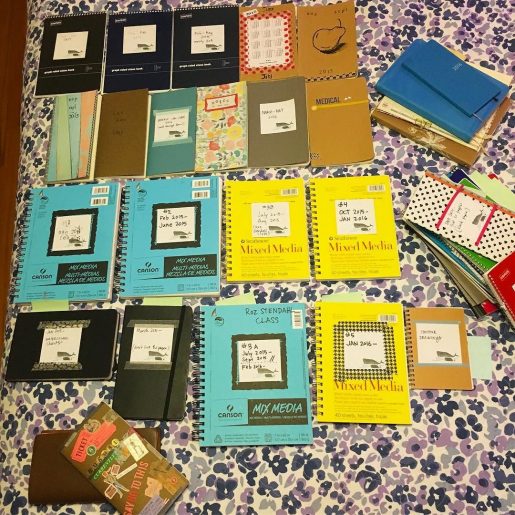
So this is not a great photo but the sight of all these books spread out on the bed delighted me. And also caused me not a small amount of chagrin—mainly that toppled stack of half-filled notebooks on the far right. This is the past two years in paper: August 2014-2016. I hadn’t realized how many sketchbooks I have filled since I started my daily drawing project two years ago this month!
The top two rows are my notebooks, about which I’ve written much in the past. They contain a hodgepodge of notes, task lists, doodles, and sketches. I used to always use small, lined spirals like the red one leaning against the stack on the right, but a couple of years ago I shifted to the black steno books up top because I like gridded paper better. Then I switched to Moleskine’s Cahier size with the kraft covers—and those are perfect little everyday scribble books, in my opinion. There are three completely filled ones in this photo (one has a gray cover, second row) plus the one I use for all our family medical notes. There’s another gray one in the only-partially-filled stack—I used about a third of it on sketches and notes at the Brave Writer Retreat last month.
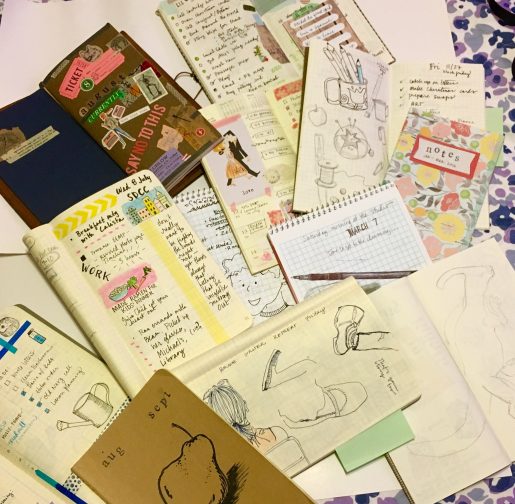
The four skinny books in row two are Midori Travelers Notebook inserts. When my pal Kristen gave me a Midori last fall, I abandoned the Moleskines (for the most part—I do grab them occasionally, as with the Bravewriter one). On the bottom left is my current Midori insert. I remain as fervently in love with my TN as ever, although I have scaled down the number and type of inserts I tote around in it. Right now I just have the gridded catch-all (collaged cover, pulled out of the cover for this photo) and a zipper pouch containing washi samples, stamps, and ephemera.
The lower two rows are my sketchbooks—although as I said, the notebooks are also crammed with drawings. In fact, I find I often prefer sketching on gridded notebook paper—I feel freer, less fussy, less concerned with getting things right. The stakes are somehow lower.
But I do love working on good sketchbook paper. The blue Canson Mixed Media books are probably my favorite type—I have learned that I prefer spiral bound sketchbooks, and I like paper with a little bit of tooth. The smaller yellow Strathmore books are also great. In fact, their paper quality is probably better and the smaller size is good for carrying around. I have completely filled two of each, and I’m working simultaneously in the ones on the bottom row. Not really any rhyme or reason to which one I pick up on a given day. Whatever’s closest to hand, usually.
The black Moleskine sketchbooks on the bottom left see a lot less use. The horizontal one contains watercolor paper and is quite lovely, but I mostly only use it for color charts. (A semi-obsession.) The vertical one is Moleskine’s standard sketchbook and it took me about twenty pages to realize I kind of hate the paper. Too smooth. I like texture and skritch. I was excited to discover I have a preference! It’s too bad, because I love the compactness of that book. It would be much easier to carry around than the Canson or Strathmore spirals.
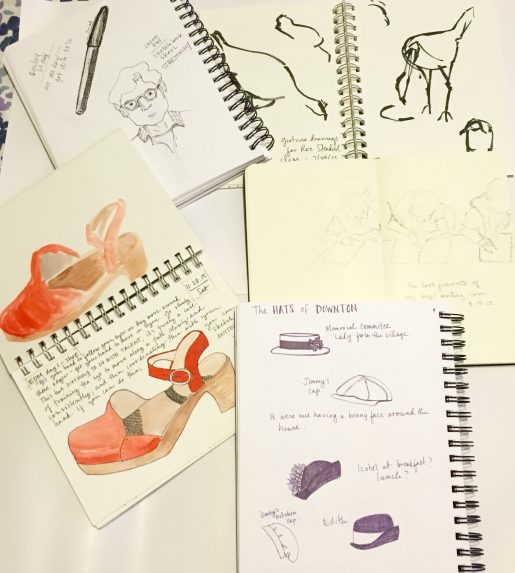
I’ve realized, though, that I don’t—at this stage, at least—do a lot of sketching or painting out in the world. When I do, it’s in one of my grid notebooks. I like the real sketchbooks for working at my desk, on my bed, or on the kitchen table. I have another big one with watercolor paper that isn’t in this photo. It doesn’t have much inside it just yet—mainly just the paintings I did at Jane LaFazio’s watercolor workshop last spring.
Middle right of the photo: my little stack of planners. Wild Simplicity Daybook, Hobonichi Cousin, Hobo Weeks. The Daybook is for homeschooling notes; the Cousin is my current bullet journal/daily calendar/scrapbook; the slender Weeks is my go-everywhere appointment book. I’ve done plenty of chattering about them before so I won’t elaborate here.
And then there’s the pile of Incompletes. I thrive on change, what can I say? Some of those books were begun for specific projects—many have to do with grants I worked on this past year. I’ll fill up the extra pages with sketches and doodles. Eventually.
Related:
2015, Year of Paper
Planner Love
Notebookery
Unearthed: the Notebooks
Actually, I guess the first couple of photos here are from March. (1) We hadn’t been to Old Town San Diego in a while and made a quick pilgrimage there one day during Wonderboy’s spring break. (2) Rilla’s bunny chain—entirely her own design—is the best Easter decoration I’ve seen in a long time. Those ears!

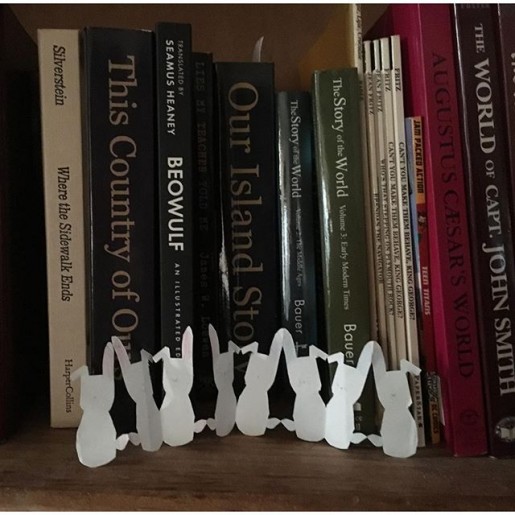
April for real:
(3) How Huck likes to rock his Math-U-See.
(4) Library day. I want that Eric Carle rug!
(5) Another library-day shot. What I love most about this photo is that the bed they’re on belongs to neither of them. It’s Beanie’s—the bottom bunk, which has long been the favorite place for my girls to sprawl. Beanie, meanwhile, does most of her own sprawling on Rilla’s bed. Go figure.
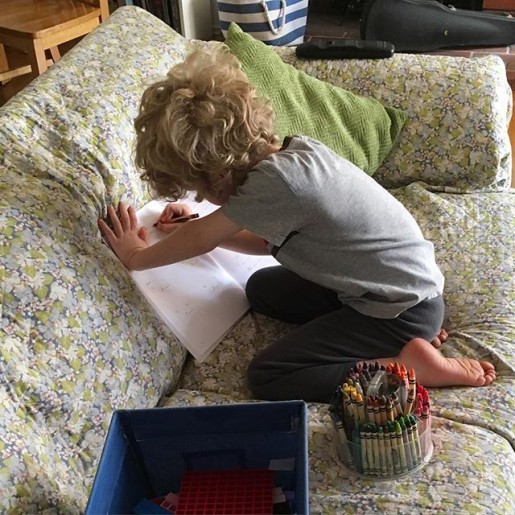
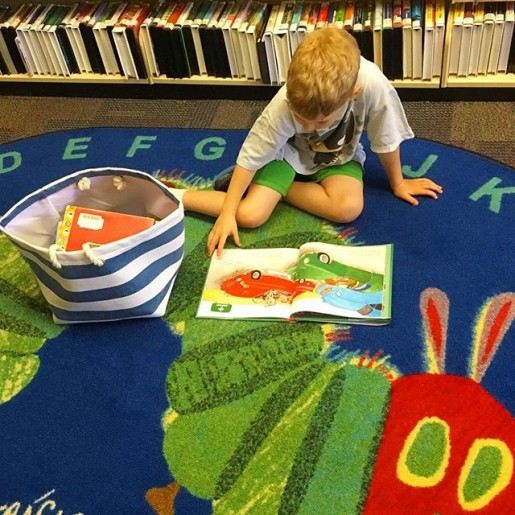
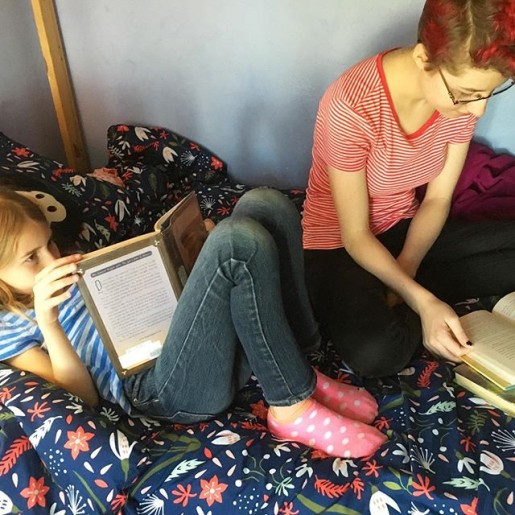
(6) Monarch caterpillar on our milkweed: always a sight that brings me joy.
(7) Wonderboy raised these sunflowers from a handful of old seeds spilled in the bottom of a bag of mostly-empty seed packets. The color surprised us!
(8) Also a surprise this year: the giant blooms on a neglected rosebush by our patio. Loads of them! It’s like Valancy went at the bush with her clippers.


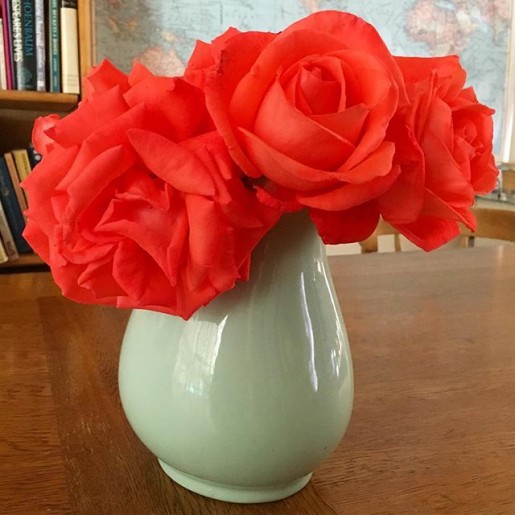
(9) Playing with a Hobonichi Techo-style layout in my bullet journal. Mary Ann Scheuer and I had a fun Skype session last week to chat about my bujo system. What’s working these days: Separate books for my messy notes and my bullet lists. It’s sort of a left brain/right brain thing: I need a space for scribbly notes of all kinds, an unkempt, all-purpose thinking-on-paper space; but I also need nice, neat(ish) to-do lists with boxes I can fill in as I accomplish tasks. It took me a LOT of years—and the revelation of the multiple-insert traveler’s notebook—to figure this out: that I need the two separate spaces.
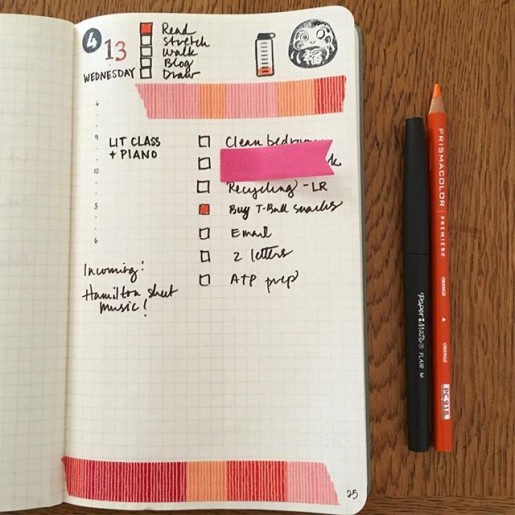
Yay, now I can fill in that ‘blog’ box!
1. Grape soda lupines—my favorite San Diego wildflower
2. Washi makes to-do lists more fun
3, 4. The milkweed is doing its glorious thing
5. Rilla’s shamrock garland
6. The wonderful Jane LaFazio doing a watercolor demo during her class
7, 8. Then it was my turn to try
9. I’m so in love with color


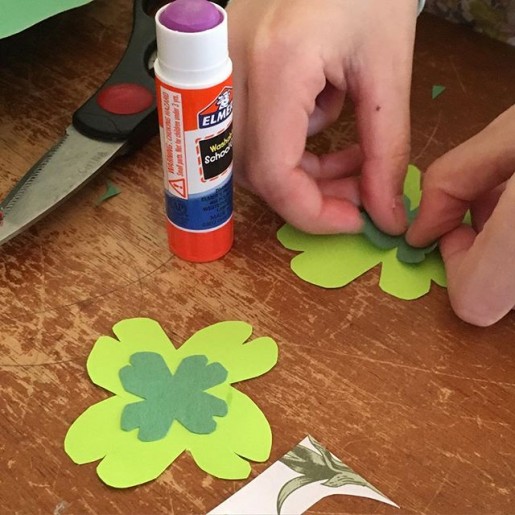






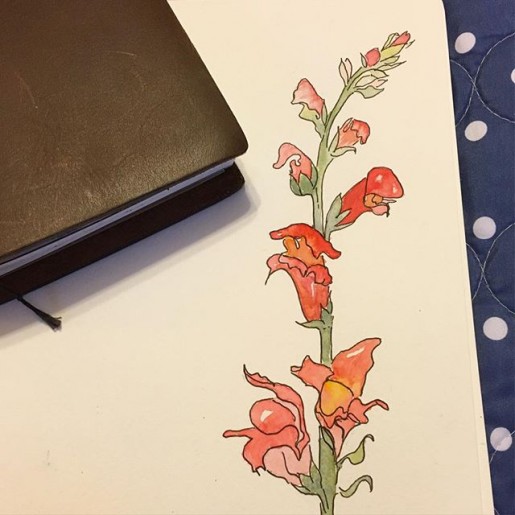
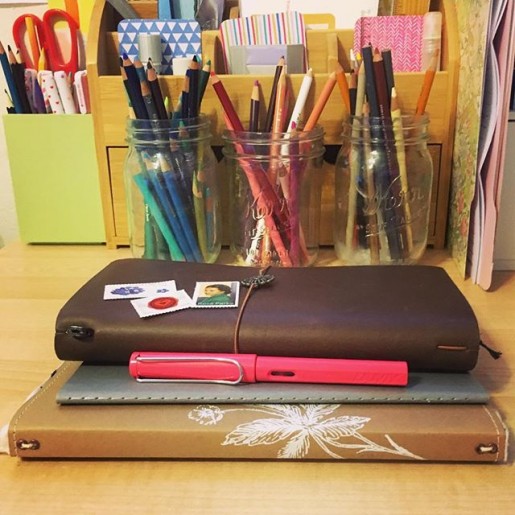
My everyday favorites. After a year of experimenting, I’ve got my system figured out. Top to bottom:
• Midori Travelers Notebook for my monthly calendar, weekly journal, and a scribble notebook;
• Moleskine Cahier for daily to-lists (bullet journal);
• Wild Simplicity Daybook for homeschooling notes and records (including our weekly Shakespeare lines—we learn monologues two lines at a time); and
• the Lamy Safari fountain pen my family gave me for my birthday. (LOVE.) (That’s an Amazon affiliate link but if you’re buying pens in the U.S., you should order from the nice people at Goulet Pen Company. Their instructional videos are invaluable, their customer service is top notch, and they offer inexpensive ink samples so you can try out all sorts of gorgeous colors. And that is not an affiliate link. I’m just a happy customer.)
I still keep the family appointments on Google Calendar, but I enjoy writing everything out in the TN monthly calendar (#017) as well. I use the horizontal weekly TN insert (#019) for chronicling the day after it happens—just a few notes about highlights. For the last several months I’ve used a blank TN insert (#003) for my bullet journal but came to realize I need a separate space for scrawling, sketching, doodling, working things out on paper. If I do that in the bullet, things get messy. WAY messy. So I’ve gone back to my old (cheaper) Moleskine grids for task lists.
The Midori travels with me everywhere; the bullet journal lives on my desk where I do most of my work; and the Daybook has a home in a basket by my rocking chair in the living room.
I’m laughing at how complicated this must seem if you aren’t a pen-and-paper fanatic…but I juggle a lot of roles (and kids) and I find having different paper spaces helps me keep things straight.
More nitty gritty:
I also have a kraft folder (#020) in my Midori to tuck ephemera and snail-mail supplies into. Since I started carrying notecards and stamps around, I’ve gotten much more prompt with my thank-you notes.
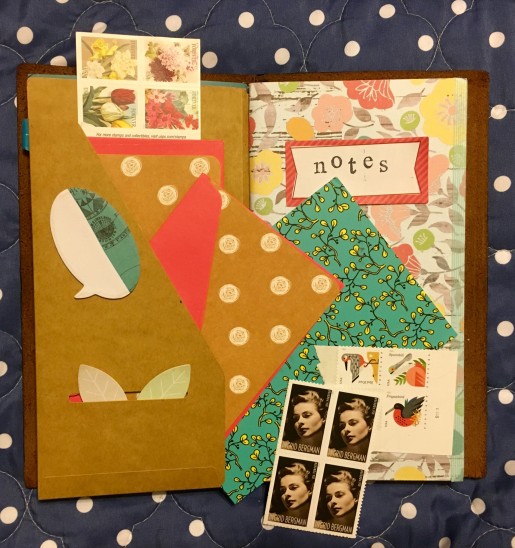
• I love the feel of Prismacolor colored pencils on the paper Lesley Austin uses in the Wild Simplicity Daybook. I’m sure I’ve raved about this before—the lovely creamy pencil on this recycled paper with just the right amount of tooth.
• Prismacolor pencils also delight me in the bullet journal: I like ’em for filling in my checkboxes.
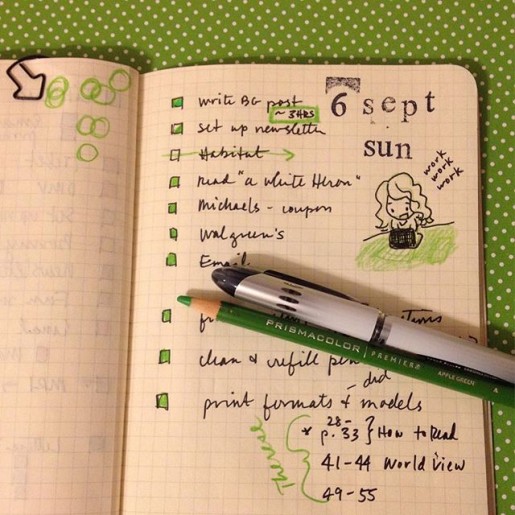
• This pic, which I’ve shared here before, shows my favorite way to organize a task list: to-do items on the right, and the verso is for related notes and numbers. I also keep a running “Nag List” on a sticky note that travels from spread to spread. It’s for important tasks that I might not get done today but I gotta deal with soon—like finishing my taxes or booking a doctor appointment. I consult it each evening when making out my bullet list for the next day.
• Sometimes I’ll tuck another insert into the Midori to be used for a specific purpose. For example, I keep a log of incoming and outgoing snail mail. I don’t like a superfat Midori, though, so more often that insert lives in my stationery pouch.
• As I mentioned, I do a lot of casual sketching in my blank Midori insert. I find I’m often more comfortable there than in my proper sketchbook, because it feels more casual. But I do have a couple of sketchbooks going and I try to work in at least one of them daily. One is a spiral-bound 7×10 Canson Mixed Media pad, which gets lukewarm reviews from real artists but I quite like its toothy paper—not to mention its price point when Michael’s has a good sale + coupon combo. You have to watch for it, but now and then they’ll give you a 20% off including sale items coupon during a buy-one-get-one-free sketchbook sale. My other sketchbook is a Moleskine Art Plus, and it’s…okay? I love its size and shape (fits nicely in my bag), but the paper is too smooth for my liking. I much prefer the feel of Moleskine’s watercolor sketchbook—a lovely texture to that paper. But so far I’ve mostly just used that for color charts.
• For sketching pens, I like Sakura Pigma Microns or my Pilot Metropolitan fountain pen (check out all the groovy colors at Goulet Pens) with Platinum Carbon ink, which is waterproof so it plays nice under watercolors. However, lately I’ve come to realize that what I enjoy most of all is sketching in pencil. I love the look of black or brown ink drawings, and most of the sketchbook artists I admire work directly in ink, but I really love the way a pencil feels on the paper. I keep hitting that point over and over, don’t I—the tactile experience matters more to me than how it looks.
Ha, this got long! Would you believe it was just going to be a quick copy-paste of something I tossed on Instagram today?

It started, I think, with my commitment to a daily sketching habit in the fall of 2014. By last January, the habit was firmly established, and I only missed a handful of days all year. January is also when I started taking “kourses” at Sketchbook Skool—which exposed me to not just the lessons and work of accomplished artists, but also to their media of choice. Which is to say: they have firm opinions about pens, making them my kind of people.
Putting pen to paper in my sketchbook reminded me how much I love that feeling. Now, I have never enjoyed doing large amounts of handwriting—I can’t write my books longhand, for example. My wrist aches after a couple of pages. But I love penmanship: other people’s, mainly. My handwriting is changeable and seldom neat. I never managed to commit to one way of shaping letters, so I wind up with different kinds of I and r and k all in one line. Last night I was numbering pages in a new bullet journal and realized that some of my 4s were the pointy kind and some were not. Happens all the time. I like change, y’all.

Anyway—I can’t write volumes by hand all at once, but I adore the feeling of a good pen on the right kind of paper. Experimenting with various pens (Pigma Micron, Le Pen, Pilot Metropolitan, Lamy Joy with 1.1 nib) reminded me how much I love analogue notetaking. So while I still find apps like Workflowy useful for tracking particular kinds of tasks, in the past few months I have shifted almost entirely to written notekeeping.
Notes on paper
Bullet journaling works very well for me. I’ve always kept a notebook as an idea and memory catch-all: phone call records, tasks completed, shopping lists, story ideas, doodles—it all winds up in the notebook in a giant jumble. Adding a bullet-journal-style index and page numbers was a revelation: now I can have my hodgepodge but find things later. Perfect.
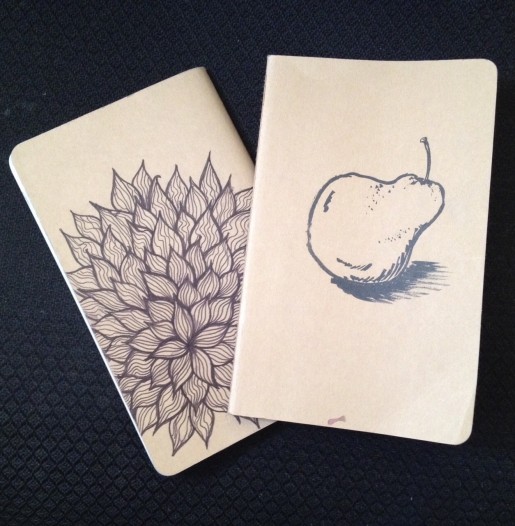
For the first part of this year I used kraft-brown Moleskine Cahiers. They’re just the right size for tucking in my bag, they’re sturdy enough to handle the beating I give them, and they fill up in a month or two which means the continual fresh start I love. Then, in August, a glorious friend surprised me with a Midori Traveler’s Notebook. It was love at first sniff. I mean, I. JUST. ADORE. THIS. THING.
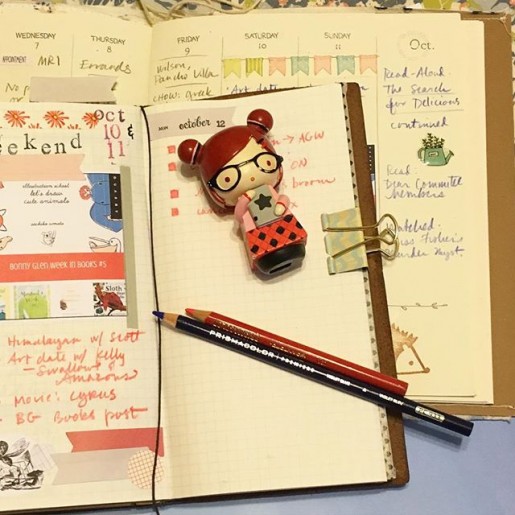
A traveler’s notebook, if you don’t know, involves a cover (usually leather, sometimes cloth or vinyl) that has a sturdy elastic cord or two strung through the spine. You slip a paper notebook under the cord to hold it in place. Then you can use additional bands to hold other inserts—various types of notebooks, folders, calendars, even plastic credit-card sleeves or zipper pouches.
My Midori set-up
After playing with my Midori for a month or two, I settled into the configuration that works best for me: a weekly calendar insert, a grid notebook, and a kraft folder that holds stickers, postage stamps, notepaper, and such. I keep a monthly calendar, too, but I don’t need to carry the whole year around with me so I have begun photocopying (and shrinking a bit) the current month and clipping that to my weekly page.

The blank grid insert is my bullet journal/idea repository/casual sketchbook, replacing the Moleskine Cahier. I number the pages and use the first page as an index, just as before. I like big fat checkboxes for my task lists, which I fill in with Prismacolor pencil as tasks are completed. Color is my happy place. 🙂 I also like to paste in ephemera and sometimes embellish with stamps, doodles, or washi tape. Basically, these inserts become collages of all the things that occupy my days and my mind. I seem to do a fair amount of sketching in them, too, even though I have an actual sketchbook for that purpose—I work in the real sketchbook daily but the TN grid insert is a low-pressure place to experiment, and I always have it with me.
Thanks to Lesley Austin’s beautiful Wild Simplicity Daybook designs, I discovered that a week-on-two-pages spread is an excellent space for me to do some chronicling. I’ve posted before about how I use the Daybook for recording homeschooling and housekeeping notes. I really like having a separate space (and such a beautiful one) for those things. I wear so many hats, and I need ways to keep my roles sorted. The Daybook (visible under my Midori in a photo above), like all of Lesley’s paper goods, conveys a sense of peace and serenity, and so it has become a really nourishing space for me to jot down my notes about what the kids read, did, said. I always feel so happy when I open that book.
Taking a cue from that experience, I decided to try the Midori week-on-two-pages for my TN. The version I selected (Refill #19) has the week in seven horizontal boxes on the left page, and a grid page for notes on the right. I use Google Calendar for our family appointments and schedules, so a couple of times a week I open G-Cal and add any new appointments to the Midori insert. At the end of each day, I create an entry on the weekly calendar page, filling it with notes about what happened that day. It isn’t a to-do list, it’s more like a diary. Not what needs to be done (that’s what the bullet journal is for), but what I actually did. The facing page fills up with quotes, ephemera, drawings, and notes on things I’ve read or watched.
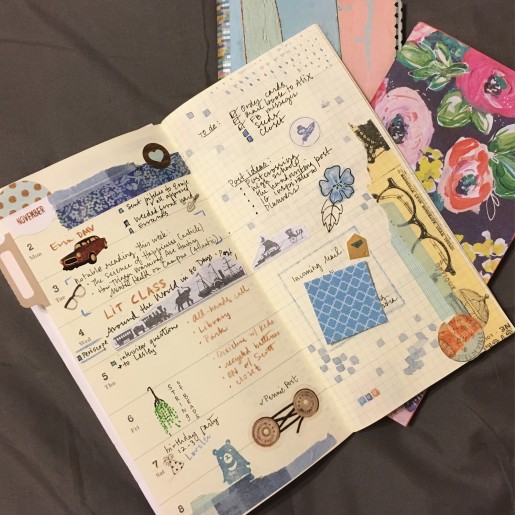
Since these pages serve as a kind of journal, I like to decorate them with washi, drawings, and watercolors. I wind up doing the ornamenting mostly on weekends. Often, I’ll start the week with two or three colors of washi in front of me, and that will set the tone for my week. This daily decorating is relaxing, it takes only moments, and I enjoy paging back through previous weeks.
So those are the two main TN inserts I carry around: the weekly calendar for journaling (more or less), and the grid notebook (Refill #2) for everything else. Those two inserts plus the kraft folder (Refill #20) make the Midori as fat as I like it to get. I could easily come up with uses for half a dozen more inserts (the TN’s capacity for letting you compartmentalize is its genius), but I found that I really prefer a non-chunky Midori.
However! I did decide to devote a single insert to all medical and health-insurance-related notes, and this has been one of my best moves ever. Instead of having those notes intermingled with everything else, they live in their own space now, with a list of phone numbers on the first page. I can tuck THAT insert into the Midori when we’re heading to an appointment. It’s perfect.
NEED MOAR PAPER
All this notebooking served to increase the satisfaction I was finding in putting pen to paper. And I found I was thinking about handwriting a lot. My little goddaughter sent me a thank-you note, and her mother’s handwriting on the envelope—the gorgeous, familiar handwriting that graced pages and pages of letters in the years after college when Krissy and I wrote to each other constantly—gave me a little jolt of joy and nostalgia. I hadn’t seen her writing in a while, and I missed it. I told her (via text, naturally) how happy I’d been to see her writing, and she said the same thing had happened to her when she saw my writing on the package I’d sent her daughter.
Shortly after that, I read that Atlantic article that was making the rounds about how the ballpoint pen killed cursive. Fascinating stuff, but the bit that grabbed me was this: “In his history of handwriting, The Missing Ink, the author Philip Hensher recalls the moment he realized that he had no idea what his good friend’s handwriting looked like. ‘It never struck me as strange before… We could have gone on like this forever, hardly noticing that we had no need of handwriting anymore.'”
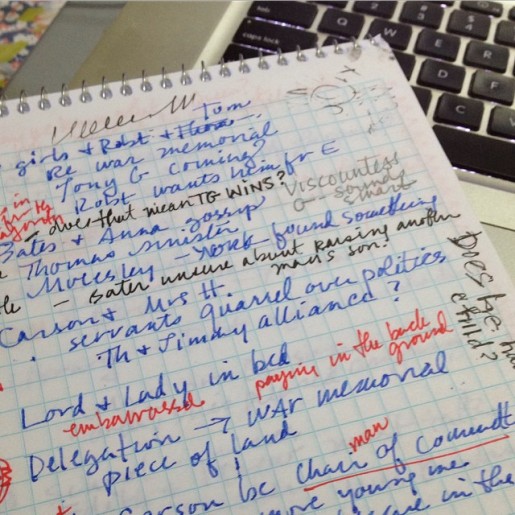
He had no idea what his good friend’s handwriting looked like. I miss handwriting, I thought. The distinct and beloved scripts of my old friends flashed before my eyes. I’d know those hands anywhere, could pick them out of any penmanship lineup. My kids probably won’t experience that. Jane has friends on the other side of the country she talks to via electronic means every single day, but they probably don’t know each other’s handwriting. I have plenty of friends myself whose writing I’ve never seen. If we met after 1995, chances are I’ve seen your handwriting seldom or never. (Tanita! What’s your writing like?)
Channeling my inner Jane Austen
The handwriting epiphany spurred me to the next phase of my analogue journey: I started writing letters again. Like, by hand. I have penpals in Denmark, France, Austria, and England, as well as various friends across the U.S.
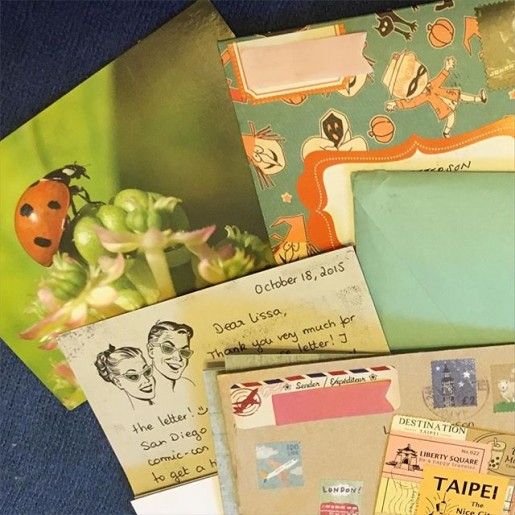
I’m amused and a little baffled that for so many years I thought of letters owing replies as a kind of guilt-ridden chore—I always took forever to answer, always had them nagging in the back of my mind. Because the truth is: snail mail is the cheapest fun around. Sure, they’re slower to write than email; slower to arrive than a Facebook message. But that’s part of the charm: the slowing down, the taking time. Just as many of us have (re)discovered the joys of slow reading in the past couple of years, I have found satisfaction in…what to call it? Not slow writing, really, because part of the point is that instead of waiting months or even (gulp) years to answer a letter, I now try to reply within three weeks; I guess what I’m enjoying isn’t about speed (or lack of it) after all. It’s about a tactile experience. The skritch of a fountain pen on flecked paper. The careful selection of stamps. The smoothing-out of a bit of washi tape across a seal. The rustle of envelopes as they slide into the box, slumbering before their journey to places I’ll never go.
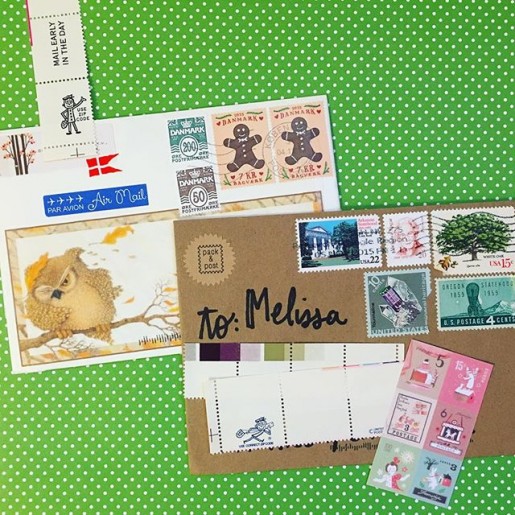
And best of all: the incoming letters. Foreign stamps, unfamiliar scripts, universal experiences. Beautifully decorated, many of them—it’s like getting mail from Griffin and Sabine. This one written at a café in Vienna; that one at a Starbucks in Portland. Kaleidoscopic glimpses of a life gradually resolving into a picture. We talk about things we could easily tell via email, but we’ve decided to let these stories take the scenic route. Some of them never arrive, or show up months later, ragged and stained. This only makes us love them more.
I’m writing to say I’ll write soon
A piece of the experience that affords me much merriment is the impulse, whenever a letter arrives, to hurry to Facebook and ping the friend who sent it. “Got your letter! Will reply soon,” I’ll write, and “Yay, can’t wait!” she’ll ping back. Never mind that the letter asks questions which could be more immediately answered via any of a dozen digital platforms. The answers will keep. Come Saturday afternoon, I’ll settle in with my cocoa, my envelopes, my wonderful new pink Lamy Safari that I got for my birthday. Which paper—the whimsical or the lovely? The fern stamps, or the Ingrid Bergmans? I’m almost out of globals, and the post office won’t have the new ones for a while. But have you seen them, the moons? I’m already imagining them on dark blue envelopes…
Our digital and analogue worlds will forever be intertwined, I believe. We’ll snap photos of our beautiful incoming mail to share on Instagram, hashtagged so our kindred spirits can find and enjoy it. We’ll trade addresses on Facebook. We’ll email to find out if that letter ever arrived. We’ll scour Etsy for traveler’s notebook inserts and stock up on ink at Goulet Pens. We’ll sign up for swaps on websites, and then anxiously check tracking to see when packages might arrive. We’ll reblog Tumblr articles about clever ways to hack a bullet journal. We’ll watch Youtube videos about how to set up a Midori and we’ll tap the heart button a zillion times during an unboxing on Periscope. We’ll link to photos of new USPS stamp releases in our blog posts. 😉
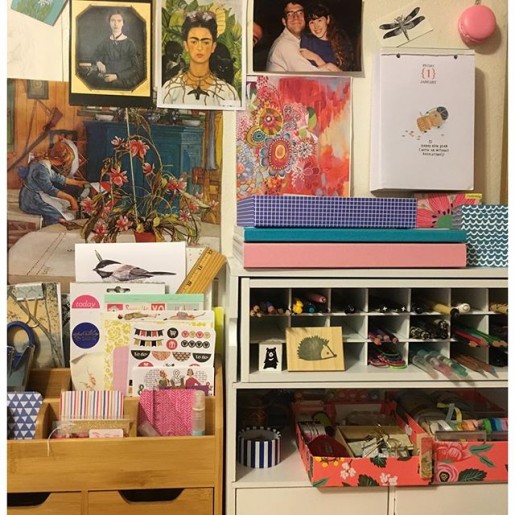
My blog, though, is perhaps the thing that suffered this past year as my attention shifted to paper and ink. I found that when I had a few quiet moments, I was more apt to want to spend them sketching or writing a letter than blogging. After ten years of a steady blog habit, that was a bit of a surprise. In January, this blog will be eleven years old. I’ve successfully figured out how to integrate my analogue and digital calendar-keeping and task-tracking, but it did take a little while for the pieces to settle into place. I expect the same will happen with blogging.
Happy New Year, friends!
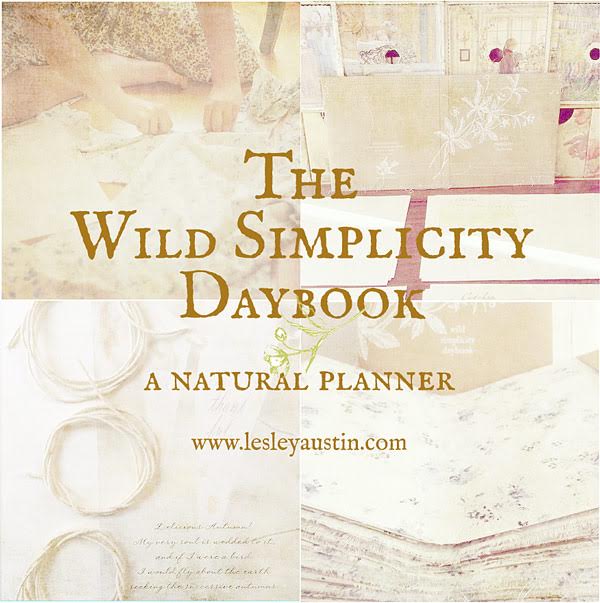
As a member of Wisteria & Sunshine, Lesley Austin’s gentle online community for home-and-hearth inspiration, I’ve had the fun of watching behind the scenes as her beautiful new Wild Simplicity Daybook took shape. Today is a day to celebrate, because the Daybook has landed in her Etsy shop!
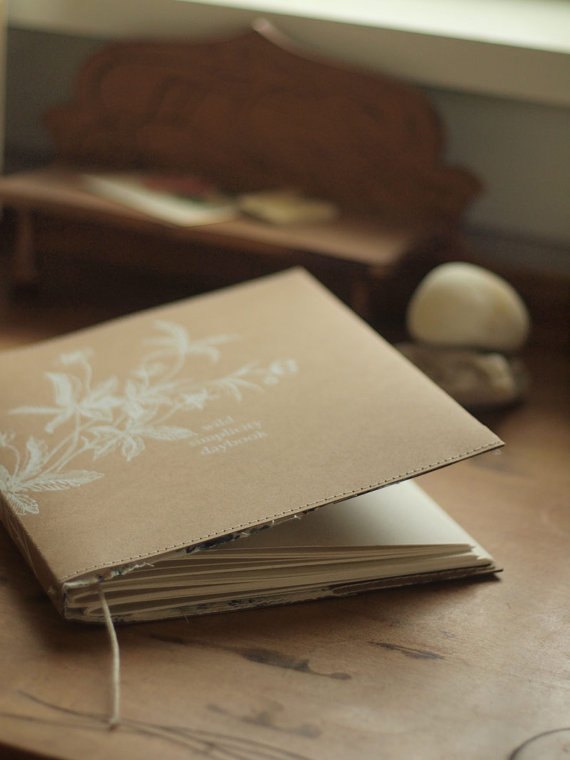
It’s a Midori-style cover made with the tender eco-friendly consciousness that suffuses all Lesley’s handmade wares, and she has created a selection of inserts to let you customize your Daybook for your own use. I’m particularly fond of Lesley’s monthly calendars (I’ve been using them in one form or another for almost a decade!), and her new weekly diary pages are the loveliest I’ve seen anywhere. She offers them in insert booklets spanning three months at a time, with the Autumn and Winter inserts currently available.
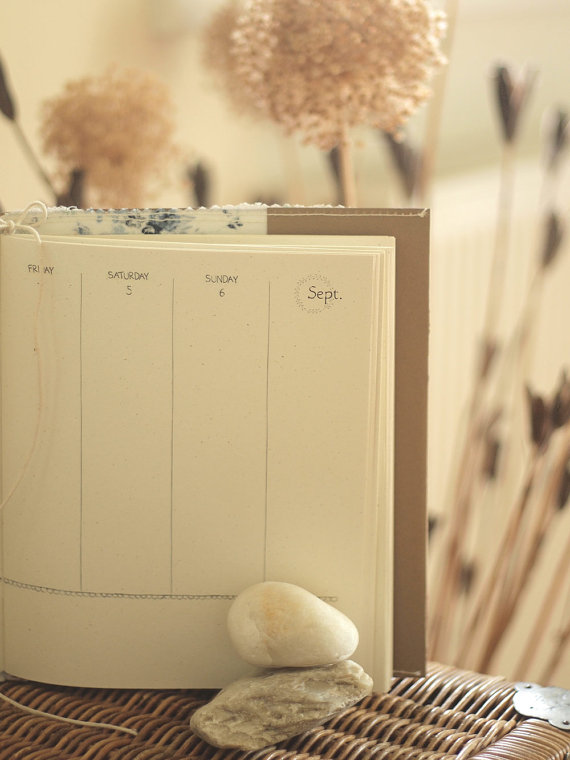
Besides the monthly and weekly calendar inserts, she is also offering blank inserts for notes or journaling and a “Days to Keep” booklet for recording birthdays, anniversaries, and other special dates.
This probably sounds like a sponsored post, but it isn’t! And Lesley didn’t ask me to write it. I am a longtime fan of her paper goods who has had the pleasure of becoming Lesley’s friend as well, and I’m so excited to see her latest venture take flight. Recently I was chatting with another friend about things we love, and I said, “I think my aesthetic is one part Waldorf kindergarten, one part library, and one part Small Meadow Press.” 🙂
This is one of those posts that will likely only appeal to a few of you, but I thought it might be useful info for some. I’ve been test-driving a task management app called WorkFlowy this week. So far, so great, I gotta say.
I’ve mentioned before that I move back and forth between listkeeping and planning on paper and on the computer, sometimes tilted more one way than the other. I love my kraft-brown Moleskine Cahier grid journals for daily notes and bullet lists (and a whole lot of doodling), and I don’t see myself ever giving up paper altogether. Especially since I started putting an index on the first page, a la the bullet-journaling method. That simple step made instant coherence out of my mishmash of notes. I refer back to old notebooks frequently and now I can find the thing I’m looking for with relative ease.

So why do I use an online task list too? Isn’t that overkill? Not really, not the way I work. I need paper notebooks for a dumping ground, but the computer helps me stay streamlined and focused. For a long while, I was using a combo of Evernote and Remember the Milk (a to-do list app, quite a good one), as described in Mystie Winckler’s Paperless Home Organization. I still stash a lot of stuff in Evernote, but somewhere along the line I fell away from using RtM.
 WorkFlowy caught my attention when I read that Stewart Butterfield’s team used it while building Slack. (Boy, the geek level in that sentence is off the charts.) Stewart shall forever be known to us former and devoted Glitch players as Stoot Barfield. Before Glitch, he co-founded Flickr. Innovative guy. Slack has become my platform of choice for IM conversation with Scott and one or two other close friends I chat with often during the day. But that’s a topic for another post.
WorkFlowy caught my attention when I read that Stewart Butterfield’s team used it while building Slack. (Boy, the geek level in that sentence is off the charts.) Stewart shall forever be known to us former and devoted Glitch players as Stoot Barfield. Before Glitch, he co-founded Flickr. Innovative guy. Slack has become my platform of choice for IM conversation with Scott and one or two other close friends I chat with often during the day. But that’s a topic for another post.
Anyway, I read about WorkFlowy and had to check it out for myself. It’s a streamlined, basic listmaking platform—and it’s marvelous. (more…)











































 WorkFlowy caught my attention when I read that Stewart Butterfield’s team used it while building Slack. (Boy, the geek level in that sentence is off the charts.) Stewart shall forever be known to us former and devoted Glitch players as Stoot Barfield. Before Glitch, he co-founded Flickr. Innovative guy. Slack has become my platform of choice for IM conversation with Scott and one or two other close friends I chat with often during the day. But that’s a topic for another post.
WorkFlowy caught my attention when I read that Stewart Butterfield’s team used it while building Slack. (Boy, the geek level in that sentence is off the charts.) Stewart shall forever be known to us former and devoted Glitch players as Stoot Barfield. Before Glitch, he co-founded Flickr. Innovative guy. Slack has become my platform of choice for IM conversation with Scott and one or two other close friends I chat with often during the day. But that’s a topic for another post.